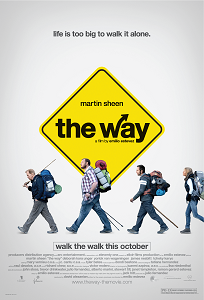Walking “The Way”
A couple of weeks ago my wife and I watched a new movie called “The Way” on DVD. We liked it so much that we saw it a second time a few days later, and then sat through it a third time to hear the commentary track by the filmmakers.
“The Way” is the story of an American opthamologist whose adult son dies accidentally while walking the five hundred mile pilgrimage to the Cathedral of Santiago de Compostela in Galicia, northwest Spain. Traveling to Spain to claim the body, the doctor decides on an impulse to continue his son’s pilgrimage. On route, he joins up with three strangers, more through happenstance than affinity, who are also pilgrims from far corners of the world.
“The Way” was produced, written, directed, and distributed by Emilio Estevez and his father Martin Sheen, who plays the lead role of the doctor, Thomas Avery. Emilio Estevez, who was forty-seven at the time of the filming in 2009, portrays the dead son Daniel, who appears in flashbacks and in his father’s “mind’s eye” at various points on the pilgrimage. El Camino de Santiago, or the Way of St. James, is a pilgrimage that dates back to the eighth century. St. Francis of Assisi was one of the early pilgrims. According to tradition, the Cathedral of Santiago de Compestela contains the bones of St. James. Estevez and Sheen (whose original name was actually Ramon Estevez) have ancestors from Galicia. Indeed, a recent episode of the TV genealogy show “Who Do You Think You Are?” follows Sheen tracing their ancestral roots. They became interested in the Camino, when Sheen and his grandson Taylor Estevez, Emilio’s son, traveled the route by car in 2003. During the journey, Taylor met his future wife, so the Camino is meaningful to all three generations of the Estevez family. Emilio decided to make a film paying tribute to the pilgrims of the Camino.
The doctor, Thomas Avery, is a widower who is not close to his son and can only shake his head in incomprehension at Daniel’s desire to “take to the road”, so his decision to follow in his late son’s path is all the more surprising. Thomas’s first traveling companion is a jolly and obese Dutchman named Jost, who refuses to leave him alone. A few days in they meet an anxious Canadian woman named Sarah who insists on calling Thomas “Boomer”, because in spite of appearances to the contrary she sees in him all the irritating cliches of American baby boomers. The fourth and last traveling companion is an Irishman named Jack, who is a verbose travel writer suffering from writers block researching new material on the Camino. Thomas has no desire to keep company with any of them, but he finds he has no choice.
In a key scene early in the film, the pilgrims register for their journey. One after another, the Camino administrators ask them, “What is your reason for going on the pilgrimage?” Thomas laughs, as if trying to come up with an answer, then responds, “I want to see more of the world.” At first this seems like the first thing off the top of his head. After all, we already believe he is doing this to grieve his son. He even carries Daniel’s backpack, still stocked for the journey, and places his ashes inside it. But thinking back to his answer at the end of the film, I find his response truer than even he may have realized at the time. Always forthright, Jost answers he needs to lose weight to fit into his tuxedo for his brother’s wedding, and then admits rather hesitantly that he wants his wife to be attracted to him again (near the end of the film, he even adds that she won’t sleep with him anymore). Sarah has a stock answer throughout the pilgrimage: she wants to stop smoking, and will lay her last pack of cigarettes at the tomb of St. James. In a later scene, however, she briefly tells Thomas that her former husband beat her, and she aborted their child so she would not be beaten too.
As for Jack, who shows up later in the film, he obviously intends to use his three traveling companions as subject matter to cure his writers block, although Thomas resists his attempts to pry his secrets from him. Indeed, Thomas resents any interest shown in him by anyone, often walking as far ahead of the other three as possible to avoid their conversation. Eventually, Jost guesses his secret, when he notices that Thomas is leaving bits of his son’s ashes at key locations, and against Thomas’s wishes he tells the others, driving Thomas further into angry silence.
Thus, the narrative follows the pattern of the classic road movie like John Ford’s “Stagecoach”, in which mismatched strangers are thrown together in the midst of a common journey. When I saw on the internet that some people compared the movie to “The Wizard of Oz” I rolled my eyes. But later listening to the commentary track on the DVD I heard Emilio Estevez himself make the comparison. He even suggested that the four pilgrims parallel Dorothy Gale and her three companions: Thomas Avery is like Dorothy, looking for his “home”; Jost the Cowardly Lion, because he lack self-esteem; emotionally bruised Sarah is the Tin Man who wants a heart; and Jack the failed writer the Scarecrow looking for a brain.
But its most obvious and earliest antecedent is Chaucer’s late 14th century “The Canterbury Tales”, in which a group of pilgrims travel to the Cathedral of Canterbury to visit the tomb of St. Thomas Becket. Except that, as my wife pointed out, those pilgrims rode on horseback and travelled about sixty miles, while the Camino pilgrims are on foot and travel over five hundred miles. And while Chaucer’s pilgrims cannot stop talking about themselves, or at least telling tales that reveal their diverse characters, the modern pilgrims of “The Way” say very little about themselves, except for Jack the writer who talks so incessantly that his companions tend to ignore him.
Indeed, the reasons the pilgrims state for their pilgrimage are not dwelled on because they themselves do not understand them. They are going on the journey to find out the reason. Early in the film, in a flashback, Thomas says to Daniel, “What are you going to do with your life?” and Daniel responds, “You don’t do anything with your life. You live it.” This is one of the main themes of the film. The reason for the journey is not to reach a destination. Like life, the journey is the destination.
But the four pilgrims are not the only travelers on the Camino, and life has a way of intruding on them in unexpected ways that jars them from their introspection. Thomas discovers he is not only on the pilgrimage to grieve his son, but is also trying to understand what meaning the pilgrimage had for Daniel by experiencing it himself, and become closer to his son after death than while he was alive.
Estevez makes clear in his script that the Camino is not a narrow religious ritual, but a journey open to all people. Near the end of the film, Thomas tells a gypsy father, “I’m not a religious man,” to which the gypsy replies, empathizing through his concern for his own young son with a man he knows has lost his, “Religion has nothing to do with it.”
Tags:movies, pilgrimage, self-discovery






One Response to Walking “The Way”